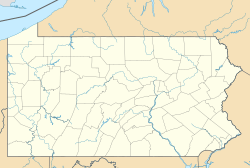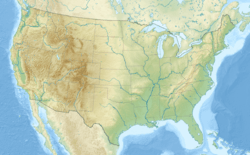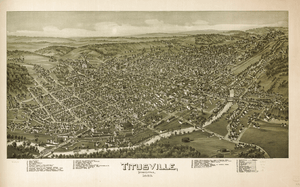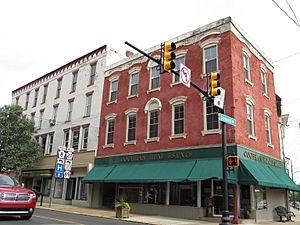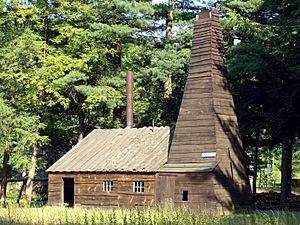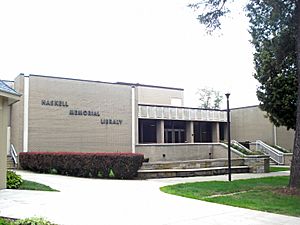Titusville, Pennsylvania facts for kids
Quick facts for kids
Titusville, Pennsylvania
|
|
|---|---|

Titusville in August 2016
|
|
| Etymology: Jonathan Titus | |
| Nickname(s):
The Queen City
|
|
| Motto(s):
The Valley That Changed the World
|
|

Location of Titusville in Crawford County, Pennsylvania
|
|
| Country | United States |
| State | Pennsylvania |
| County | Crawford |
| Incorporated (city) | February 28, 1866 |
| Founded by | Jonathan Titus |
| Region government/seat | Council–manager |
| Area | |
| • Total | 2.90 sq mi (7.51 km2) |
| • Land | 2.90 sq mi (7.51 km2) |
| • Water | 0.00 sq mi (0.00 km2) |
| Elevation
(middle of city)
|
1,200 ft (400 m) |
| Highest elevation
(northeast corner of city)
|
1,621 ft (494 m) |
| Lowest elevation
(Oil Creek)
|
1,150 ft (350 m) |
| Population
(2020)
|
|
| • Total | 5,262 |
| • Density | 1,778.3/sq mi (686.62/km2) |
| Time zone | UTC-4 (EST) |
| • Summer (DST) | UTC-5 (EDT) |
| ZIP Code |
16354
|
| Area code(s) | 814 |
| FIPS code | 42-76904 |
Titusville is a city in the eastern part of Crawford County, Pennsylvania, United States. In 2020, about 5,262 people lived there. Titusville is famous as the place where the American oil industry began. For many years, it was the world's top oil-producing area. It was also known for its lumber industry, with many sawmills, and later for making plastics and tools. It is part of the Meadville micropolitan area.
Contents
History of Titusville
The area was first settled in 1796 by Jonathan Titus. Over the next 14 years, more people bought land near his. They settled along the banks of what is now Oil Creek. Titus first named the village Edinburg(h). But as it grew, people started calling it Titusville. The village became a borough in 1849. It grew slowly until the 1850s, when oil was found nearby.
People knew oil was in the ground, but they didn't have a good way to get it out. Back then, oil was mostly used as medicine for people and animals. In the late 1850s, the Seneca Oil Company sent Col. Edwin L. Drake to drill for oil. He leased land just south of Titusville, near what is now Oil Creek State Park. In the summer of 1859, Drake hired William A. Smith, a driller who usually dug for salt. They faced many problems. But on August 27, they finally drilled a well that could produce oil for sale. This happened near an oil spring just south of Titusville.
After oil was found, people needed a way to move it. Teamsters, who drove horse-drawn wagons, transported the oil to markets. In 1862, the Oil Creek & Titusville Railroad was built. It connected Titusville to Corry. From Corry, the oil was moved to larger train lines. In 1865, pipelines were built to carry oil directly to the trains. This meant teamsters were no longer needed as much. The next year, the train line went south to Petroleum Centre and Oil City. Another railroad, the Union & Titusville Railroad, was built in 1865. This line became part of the Philadelphia and Erie Railroad in 1871. That fall, President Ulysses S. Grant visited Titusville to see this important oil region.
Many businesses related to oil quickly started up. Eight oil refineries were built between 1862 and 1868. Refineries turn crude oil into useful products. Tools for drilling were also needed, so several iron factories were built. Titusville grew very fast, from 250 people to 10,000 almost overnight. In 1866, it officially became a city. In 1871, the first oil exchange in the United States opened there. An oil exchange is a place where oil is bought and sold. The exchange later moved, but came back in 1881 to a new building. It closed down in 1897.
The first oil millionaire was Jonathan Watson, who lived in Titusville. He owned the land where Drake's well was drilled. Before the well's success, he was in the lumber business. At one point, people said Titusville had more millionaires per person than any other place in the world.
A notable resident was Franklin S. Tarbell. His large Italianate style home is still standing. He first moved a few miles south to Venango County. There, he started a business making wooden tanks for oil. About 10 miles (16 km) southeast of Titusville was another oil boom city called Pithole. Oil was found there in January 1865. By September 1865, its population was 15,000. But the oil quickly ran out, and within four years, the city was almost empty. Tarbell moved to Titusville in 1870. His daughter, Ida Minerva Tarbell, grew up hearing and smelling the oil industry. She became a famous writer. She wrote articles about how the Standard Oil Company and its president, John D. Rockefeller, did business. Her writings led to new laws in Congress about monopolies, which are when one company controls an entire industry.
Fires were a big danger around oil. One of the worst fires happened on June 11, 1880. It was called "Black Friday." Almost 300,000 barrels of oil burned after lightning hit an oil tank. The fire burned for three days. It caused $2 million in damage, but no one died. Another fire happened on June 5, 1892. Oil Creek flooded, and a tank of petroleum ether spilled. The petroleum ether caught fire. In the explosions that followed, 60 people died. Another lightning strike in 1894 caused 27,000 barrels of oil to be lost in a fire.
Oil production in Pennsylvania was highest in 1891. After that, other industries started in Titusville. Iron and steel factories were important in the early 1900s. Lumber also became a major industry again. Oil is still used in Titusville today. Charter Plastics, for example, uses oil in its products. Their factory used to make parts for the oil industry.
Geography and Climate
Titusville is located at 41.629 degrees North latitude and -79.674 degrees West longitude.
The city covers about 2.9 square miles (7.5 square kilometers) of land. There is no water area within the city limits.
Titusville is located:
- 44.4 miles south of Erie, Pennsylvania
- 83.6 miles North of Pittsburgh, Pennsylvania
- 122.9 Miles East of Cleveland, Ohio
- 120.5 Miles South of Buffalo, New York
- 78.2 Miles North East of Youngstown, Ohio
Weather in Titusville
| Climate data for Titusville, Pennsylvania (1991–2020 normals, extremes 1954–present) | |||||||||||||
|---|---|---|---|---|---|---|---|---|---|---|---|---|---|
| Month | Jan | Feb | Mar | Apr | May | Jun | Jul | Aug | Sep | Oct | Nov | Dec | Year |
| Record high °F (°C) | 68 (20) |
74 (23) |
81 (27) |
88 (31) |
91 (33) |
94 (34) |
100 (38) |
96 (36) |
97 (36) |
87 (31) |
78 (26) |
72 (22) |
100 (38) |
| Mean daily maximum °F (°C) | 32.8 (0.4) |
35.3 (1.8) |
44.0 (6.7) |
57.9 (14.4) |
69.4 (20.8) |
77.3 (25.2) |
81.0 (27.2) |
79.6 (26.4) |
73.4 (23.0) |
61.2 (16.2) |
48.3 (9.1) |
37.2 (2.9) |
58.1 (14.5) |
| Daily mean °F (°C) | 23.9 (−4.5) |
24.8 (−4.0) |
33.1 (0.6) |
45.2 (7.3) |
56.4 (13.6) |
64.9 (18.3) |
68.9 (20.5) |
67.3 (19.6) |
61.0 (16.1) |
49.4 (9.7) |
38.6 (3.7) |
29.2 (−1.6) |
46.9 (8.3) |
| Mean daily minimum °F (°C) | 15.0 (−9.4) |
14.3 (−9.8) |
22.3 (−5.4) |
32.5 (0.3) |
43.3 (6.3) |
52.6 (11.4) |
56.7 (13.7) |
55.0 (12.8) |
48.7 (9.3) |
37.6 (3.1) |
28.8 (−1.8) |
21.3 (−5.9) |
35.7 (2.1) |
| Record low °F (°C) | −31 (−35) |
−37 (−38) |
−20 (−29) |
4 (−16) |
17 (−8) |
26 (−3) |
34 (1) |
32 (0) |
21 (−6) |
11 (−12) |
−1 (−18) |
−22 (−30) |
−37 (−38) |
| Average precipitation inches (mm) | 3.53 (90) |
2.70 (69) |
3.49 (89) |
4.24 (108) |
4.05 (103) |
4.86 (123) |
4.25 (108) |
3.58 (91) |
4.06 (103) |
4.22 (107) |
3.63 (92) |
3.72 (94) |
46.33 (1,177) |
| Average snowfall inches (cm) | 24.3 (62) |
18.5 (47) |
12.5 (32) |
2.8 (7.1) |
0.0 (0.0) |
0.0 (0.0) |
0.0 (0.0) |
0.0 (0.0) |
0.0 (0.0) |
0.8 (2.0) |
8.5 (22) |
22.0 (56) |
89.4 (227) |
| Average precipitation days (≥ 0.01 in) | 18.8 | 15.0 | 14.0 | 14.6 | 12.9 | 12.8 | 11.4 | 10.6 | 10.4 | 14.1 | 14.4 | 17.4 | 166.4 |
| Average snowy days (≥ 0.1 in) | 13.9 | 10.6 | 6.7 | 1.7 | 0.0 | 0.0 | 0.0 | 0.0 | 0.0 | 0.4 | 3.9 | 10.4 | 47.6 |
| Source: NOAA | |||||||||||||
Natural Features of Titusville
Titusville is in the southeastern part of Crawford County. It is located in the Pittsburgh High Plateau region. Oil Creek flows south through the city. It is a branch of the Allegheny River. Two smaller streams, Pine Creek and Church Run, also flow into Oil Creek here. The lowest point in Titusville is 1,150 feet (350 m) above sea level. This is where Oil Creek leaves the city. The highest point is 1,650 feet (500 m) high. This high point is in the northeastern corner of the city.
Population of Titusville
| Historical population | |||
|---|---|---|---|
| Census | Pop. | %± | |
| 1850 | 245 | — | |
| 1860 | 438 | 78.8% | |
| 1870 | 8,639 | 1,872.4% | |
| 1880 | 11,982 | 38.7% | |
| 1890 | 12,786 | 6.7% | |
| 1900 | 11,738 | −8.2% | |
| 1910 | 9,982 | −15.0% | |
| 1920 | 8,432 | −15.5% | |
| 1930 | 8,055 | −4.5% | |
| 1940 | 8,126 | 0.9% | |
| 1950 | 8,923 | 9.8% | |
| 1960 | 8,356 | −6.4% | |
| 1970 | 7,331 | −12.3% | |
| 1980 | 6,884 | −6.1% | |
| 1990 | 6,434 | −6.5% | |
| 2000 | 6,146 | −4.5% | |
| 2010 | 5,601 | −8.9% | |
| 2020 | 5,262 | −6.1% | |
| Sources: | |||
In 2017, there were about 5,418 people living in Titusville. There were 2,397 households and 1,337 families. The population density was about 1,931 people per square mile. Most people (96.2%) were White. About 1.9% were African American, and 0.9% were Asian. About 1.2% of the population was Hispanic or Latino.
About 25.4% of households had children under 18. The average household had 2.23 people. The average family had 2.91 people.
The median age in the city was 40.1 years. About 22.8% of the population was under 18. About 19.9% were 65 or older.
Getting Around Titusville
- Crawford Area Transportation Authority
- Titusville Regional Airport
Historical Markers in Titusville
These markers tell about important places and events in Titusville's history:
- Titusville Early Refinery
- Edwin L Drake Tombstone
- The John Heisman Memorial
- Oil Creek State Park
- Titusville Oil Exchange
Fun Things to Do in Titusville
- The Drake Well Museum and Park: This museum tells the story of the first oil well in America. It was drilled in 1859 by "Colonel" Edwin Drake along Oil Creek. You can see a rebuilt oil well that shows how they first got oil out of the ground. The museum is located about 2 miles (3.2 km) south of Titusville.
- Tarbell House
- Pithole Museum & Visitor Center: Learn about a famous oil boomtown that was destroyed by fire.
- South Franklin Street Bridge: A historic steel bridge in the middle of Titusville.
- Benson Memorial Library: A beautiful old building in the Victorian style.
- Oil Creek and Titusville Railroad: Take a ride on this tourist train. It goes from Titusville to Rynd Farm.
- Titusville Historical Society & Heritage Center
- Titusville City Hall: This building is a National Historic Site.
- Great Eastern Cutlery: A factory that makes knives.
- Oil Creek Family Campground: Located in Oil Creek State Park.
- Burgess Park Splash Pad: A fun water play area.
Festivals in Titusville
- OilFest: This is a large daytime festival held in Titusville.
- Home for the Holidays: Christmas activities in December.
- Heart of the Arts folk and music festival
- Titusville Summer Concert Series
Education in Titusville
The Titusville Area School District serves the area. It includes:
- Titusville High School
- Titusville Middle School
- Mainstreet Elementary
- Pleasantville Elementary
- Hydetown Elementary
- ECLC
Universities in Titusville
- University of Pittsburgh at Titusville
- Northern Pennsylvania Regional College
Famous People from Titusville
Many interesting people have connections to Titusville:
- Joseph Bushnell Ames (1878–1928), a novelist.
- J. J. Bleday (born 1997), a baseball player for the Miami Marlins. He went to Titusville High School.
- Julien Bryan (1899–1974), a photographer and filmmaker during World War II.
- Edwin L. Drake (1819–1880), the first American to successfully drill for oil in Titusville.
- William Draper Harkins (1873–1951), a chemist known for his work in nuclear chemistry.
- Ray Harroun (1879–1968), a race car driver and the first winner of the Indianapolis 500.
- John Heisman (1869–1936), a famous football player and coach.
- Helen Jepson (1904–1997), an opera singer.
- John Washington Steele (1843–1920), a wealthy oilman and the first millionaire from oil.
- Ida Tarbell (1857–1944), a teacher and journalist.
See also
 In Spanish: Titusville (Pensilvania) para niños
In Spanish: Titusville (Pensilvania) para niños


